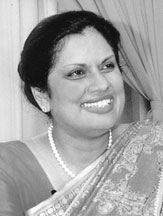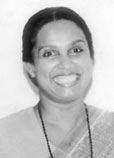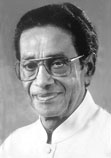1994, 1999 - Democracy's triumph over terror
Following the second Presidential election in 1988, Sri Lanka
witnessed the bloodiest Presidential elections in 1994 and 1999 where
main Presidential candidates from main political parties faced their
worst experiences with one Presidential candidate Gamini Dissanayake
killed in a bomb blast in 1994 and Chandrika Bandaranaike Kumaratunga
having a narrow escape from a suicide bomber, with the loss of an eye.
 |
 |
|
Chandrika
Kumaratunga |
Vasudeva
Nanayakkara |
After the assassination of President Ranasinghe Premadasa by a LTTE
suicide bomber on May 1, 1993, then Prime Minister, Dingiri Banda
Wijetunga was sworn in as the President of Sri Lanka according to the
Constitution of the country and he continued as the President till the
next Presidential election held on November 9, 1994.
The year 1993, became a year of political transition as the
Opposition parties were uniting under one flag to defeat the UNP regime
which was in power for more than 17 years.
The country was in need of a regime change which could restore peace
and law and order against the continued violence and political killings
that had deeply enrooted in the society. Chandrika Bandaranaike
Kumaratunga, the younger daughter of former Prime Ministers S.W.R.D.
Bandaranaike and Sirimavo Bandaranaike who returned to the country from
UK gave leadership to the SLFP led opposition parties who were searching
for a leadership to make a change.
A broader alliance was formed among the opposition political parties
to contest the 1994 General election against the ruling UNP regime which
was run by President D.B. Wijetunga and Prime Minister Ranil
Wickremesinghe, after the demise of President Ranasinghe Premadasa.
This alliance led by Chandrika Kumaratunga secured a majority of
seats with the support of the Sri Lanka Muslim Congress and an upcountry
Tamil political party to form a new government. Following the 1994
August General election, Sri Lanka, for the first time experienced a
cohabitation regime in which the incumbent President was from a
different political party whilst the Parliamentary majority was enjoyed
by another political party.
After the People's Alliance came to power at the 1994 August General
election and Kumaratunga became the Prime Minister, President D.B.
Wijetunga made a Presidential Proclamation to hold a Presidential
election.
The Elections Commissioner issued a gazette notification calling
nominations for the Presidential election. Nominations were accepted on
October 7, 1994.
Four nominations from recognized political parties and two
nominations from Independent candidates were accepted by the Elections
Commissioner on October 7 between 11 am to 12 noon.
Prime Minister Chandrika Bandaranaike was the candidate of the
People's Alliance and contested under the symbol Chair. The United
National Party fielded Gamini Dissanayake who returned to his home base
United National Party after the demise of Ranasinghe Premadasa, as their
Presidential candidate.
The Sri Lanka Progressive Front handed over the nomination of
Galappaththi Arachchige Nihal as their candidate to contest under the
symbol (Flower Vase) while Sinhale Maha Sammatha Boomi Putra Party
fielded Dr. Harishchandra Wijetunga as their candidate to contest under
the symbol Plane. A.J. Ranasinghe and Hudson Samarasinghe handed over
their nominations as independent candidates under the symbols Swan and
Table respectively.
The election date was fixed for November 9, 1994. The North East
ethnic issue, bribery and corruption, state terror, human right
violations were the main slogans at the Presidential election.
Before and during the campaign for the Parliamentary elections,
Chandrika Kumaratunga adopted a conciliatory stance towards Tamils and
Muslims and campaigned for a political solution for the North-East issue
and pledged to change the Constitution to accommodate a political
solution to solve the ethnic issue.
The main political parties including the moderate Tamil United
Liberation Front decided to extend their support to the candidacy of
Chandrika Bandaranaike Kumaratunga.
The main Opposition United National Party could not obtain the
support of the minority Tamil community as it attacked the campaign of
Chandrika Kumaratunga for aligning towards minority Tamils. Dissanayake
also carried out a campaign to reduce the powers of the Executive
Presidency.
|
 |
|
Srima
Dissanayake |
|
 |
|
A.J.
Ranasinghe |
|
 |
Chandrnanda
de Silva |
However, the election campaign saw a dramatic change after the UNP
candidate Gamini Dissanayake was killed in a bomb explosion along with
53 others including major leaders of the UNP while participating at a
propaganda rally in Colombo on October 24, 1994.
Following the demise of Gamini Dissanayake the UNP decided to field
the widow of Gamini Dissanayake Srima Dissanayake as their candidate.
Therefore, the Presidential election became race between two women
both of whom lost husbands to assassins. They both pledged to seek
peace. But they differ sharply on how to end the revolt by the Tigers.
At the end the Prime Minister Chandrika Kumaratunga emerged
victorious at the Presidential election obtaining an unprecedented 62.28
percent of the vote against her relatively weak opponent Vajira
Srimathie Dissanayake who obtained only 35.91 percent of votes.
Chandrika Kumaratunga was able to win all the electoral districts
except Mahiyangana and had more than 80 percent of the vote in the North
especially in Jaffna.
Chandrika Kumaratunga obtained 4,709,205 votes against the 2,715,285
votes obtained by Shrimathie Dissanayake.
The other candidates Hudson Samarasinghe received 58,886 votes,
Harishchandra Wijetunga 32,651 votes, A.J. Ranasinghe 22,752 and Nihal
Galappatti 22,749 votes.
After assuming office as the fifth executive President of the country
President Chandrika Bandaranaike Kumaratunga tried to woo the Tigers to
peace talks but had to return to the war path once the LTTE broke the
Ceasefire Agreement on April 19, 1995. Her attempts to change the
Constitution also failed as she could not garner the required majority
to go ahead with those proposals.
Therefore, in 1999 she decided to go for a fresh mandate calling an
early Presidential election ahead of a General election.
Nominations were accepted on November 16, 1999 for the Presidential
election slated for December 21, 1999.
A record number of 13 candidates, 11 from registered political
parties and two independent candidates handed over their nominations to
the Elections Commissioner’s Office at Rajagiriya on November 21.
President Chandrika Bandaranaike Kumaratunga from the People’s
Alliance, Opposition Leader Ranil Wickremesinghe from the United
National Party, Nandana Gunatilleka from the Janatha Vimukthi Peramuna,
Harishchandra Wijetunga from the Sinhalaye Maha Sammatha Boomi Puthra
Party, Rajeeva Wijesinghe from the Liberal Party, Vasudeva Nanayakkara
from the Democratic Left Front, Abdul Rasool from the Sri Lanka Muslim
Katchi, Alwis Weerakkodi Premawardhena from the People’s Freedom Front,
Ariyawansha Dissanayake from the Democratic United National Front, Alwis
Weerakkodi from the United National Front, Kamal Karunadasa from the
People’s Liberation Solidarity Front and two independent candidates
W.V.M. Ranjith and Hudson Samarasinghe filed their nominations to
contest the elections.
Bribery and corruption, Constitutional change, changing the Executive
Presidency and the resolution of the North-East problem were the main
slogans of the election campaign.
This time too all constituent parties of the People’s Alliance
extended their support to President Chandrika Kumaratunga despite
reservations some political parties had with the President.
However, during the campaign President Kumaratunga vowed to take
military action against the LTTE while inviting them to enter political
negotiations shedding the path of violence.
Her rival Opposition Leader Ranil Wickremesinghe called for the
commencement of direct negotiations with the LTTE.
Eight days before the election, the LTTE made an attempt to
assassinate President Kumaratunga while she was above to leave an
election rally at Town Hall Colombo.
She lost her right eye but managed to continue as the candidate of
the PA.
President Kumaratunga emerged victorious at the election obtaining
4,312,157 votes equal to 51.12 percent of votes against her close rival
Ranil Wickremesinghe who managed to obtain 3,602,748 votes (42.71
percent).
There was a major shift in the minority vote base towards the UNP
candidate Ranil Wickremesinghe as he managed to obtain majority votes in
the North and East and minority dominated areas.
President Chandrika Kumaratunga took her oaths as the sixth executive
President of Sri Lanka whilst undergoing treatment for her eye to
commence her second tenure of Presidency. |

